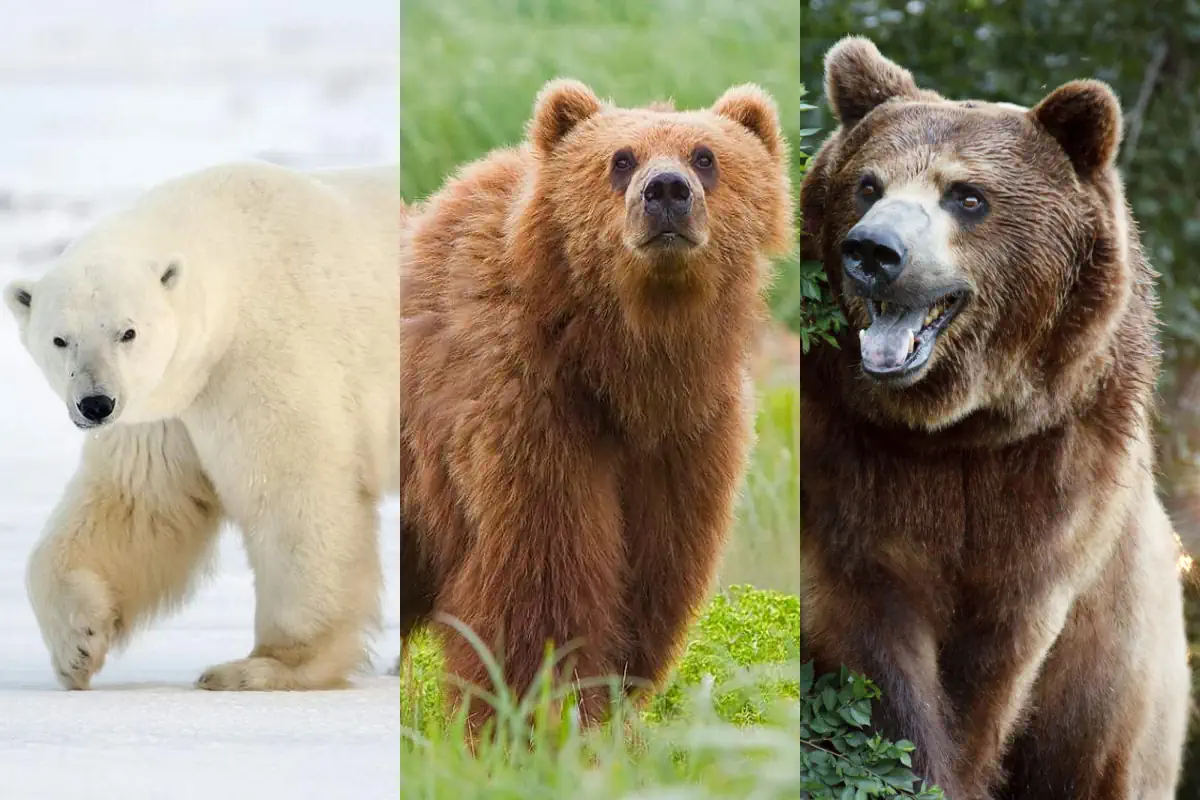Polar bears, Kodiak bears, Grizzly bears, and Kamchatka brown bears are among the largest bear species in the world. But, which one is the biggest bear in the world?
- Adult male grizzlies weigh 180-360 kg (400-790 lb) on average. They can be more than 500 kg (1,100 pounds). When they stood, their average total height is 198 cm (6.50 feet). But, occasionally, huge male grizzlies have been observed, whose size greatly exceeds the average. 3 meters (9.8 feet) tall male grizzlies on their hind legs have been reported.
- Kamchatka brown bears (scientific name: Ursus arctos beringianus) are among the largest bears in the world. They are slightly bigger than grizzlies: Male Kamchatka brown bears can have a body length of up to 3 meters (9.8 feet) tall on hind legs, and a weight of up to 650 kg (1,430 lb).
- The Kodiak bear (scientific name: Ursus arctos middendorffi) usually reaches sizes of 600 kg (1,320 lb) and has even been known to exceed a weight of 680 kg (1,500 lb). A large male could reach a height of 3 meters (9.8 feet) when standing fully upright on its hind legs. The Kodiak bear is considered the biggest brown bear in the world.
- On average, A boar (adult male) polar bear weighs around 350-700 kg (772-1,543 lb. Large specimens can be more than 800 kg (1,763 lbs) and stand more than 3 meters (9.8 feet) tall when standing fully upright.
The polar bear is the largest bear in the world
The polar bear (Ursus maritimus) is the biggest bear in the world. It is also the largest hypercarnivorous land mammal species on Earth (see notes 1, the omnivorous Kodiak bear is approximately the same size, but still, the polar bear is considered slightly bigger).
The largest Grizzly bear on record
The largest grizzly bear ever recorded (and properly measured) was 2.74 meters tall (9 feet). It was killed by a hunter in Alaska.
However, a grizzly skull discovered by an Alaskan taxidermist in 1976 surpassed the size of that record-breaking grizzly bear’s skull. This finding suggests that the skull may have belonged to an even larger grizzly bear.

Related: 20 Amazing Grizzly Bear Facts
The largest Kamchatka brown bear on record
A skull of a Kamchatka brown bear, founded in 2013, scored 30 11/16 SCI points (Safari Club International). Based on the skull, the animal can be at least 3 meters (9.8 feet) tall.

The largest Kodiak bear on record
The largest Kodiak Bear ever recorded is the famous 1700-pound (771 kg) world record brown bear which is on display in Anchorage Airport, Alaska. It is also the biggest brown bear ever recorded. The huge bear stands about 10 feet (3.05 meters) tall, standing on its hind legs.
The huge bear also holds the largest skull record in brown bears.

The largest polar bear on record [also the largest bear ever recorded]
The largest polar bear on record was a male shot at Kotzebue Sound in northwestern Alaska in 1960. The giant bear reportedly weighed 1,002 kg (2,209 lb), and when mounted, stood 3.39 meters (11 feet and 1 inch) tall on its hind legs.
Overall, this specimen is the largest bear in the world ever recorded.


Related: 20 Amazing Polar Bear Facts
The largest bear ever lived: South American short-faced bear
The largest known terrestrial mammalian carnivoran of all time was (possibly) the South American short-faced bear (Arctotherium) source 1 source 2. Big males of this species would have weighed more than 1,500 kg (3,307 lb) and stood at least 11 feet (3.4 meters) tall on the hind limbs.
A specimen from Buenos Aires shows an individual estimated, using the humerus, to weigh between 983 and 2,042 kg (2,167 and 4,502 lb), though the authors consider the upper limit as improbable and say that 1,588 kg (3,501 lb) is more likely.


Related: Largest Prehistoric Mammals
Notes
- If an animal has a diet that is more than 70% meat then it’s called a hypercarnivore. All felids, including your house cat, are hypercarnivorous, for example. Some examples include crocodiles, alligators, owls, shrikes, eagles, felids, dolphins, orcas, snakes, spiders, scorpions, mantises, marlins, groupers, and most sharks. Most wild canids (wolves, foxes, etc) and domesticated dogs are not hypercarnivorous).
- Moon Landings: All-Time List [1966-2025] - February 2, 2025
- What Is Max-Q and Why Is It Important During Rocket Launches? - January 16, 2025
- Top 10 Tallest Rockets Ever Launched [2025 Update] - January 16, 2025

